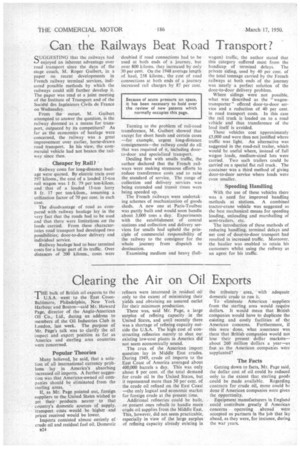Can the Railways Beat Road Transport?
Page 58

If you've noticed an error in this article please click here to report it so we can fix it.
QUGGESTING that the railways had 1.--) enjoyed an inherent advantage over road transport since the days of the stage coach, M. Roger Guibert, in a paper on recent developments in French railway terminal services, indicated possible methods by which the railways could still further develop it. The paper was read at a joint meeting of the Institute of Transport and of the Societd des Ingdnieurs Civils de France on Wednesday.
From the outset, M. Guibert attempted to answer the question, is the railway doomed as a means for transport, outpaced by its competitors? As far as the economics of haulage were concerned, the railway was a great improvement over earlier, horse-drawn road transport. In his view, the commeroial vehicle had not beaten the railway since then.
Cheaper by Rail?
Railway costs for long-distance haulage were quoted. By electric train over 597 kiloms., the cost of a loaded I5-ton rail wagon was 1 fr. 79 per ton-kilom. and that of a loaded 15-ton lorry 8 fr. 17 per ton-kilom., assuming a utilization factor of 70 per cent. in each case.
The disadvantage of road as compared with railway haulage lay in the very fact that the roads had to be used and that there were limitations on the loads carried. From these characteristics road transport had developed two possibilities; door-to-door delivery and individual service.
Railway haulage had to bear terminal costs for a large part of its traffic. Over distances of 200 kiloms., costs were doubled if road connections had to be used at both ends of a journey, but over 800 kiloms. they increased by only 30 per cent. On the 1948 average length of haul, 258 kiloms., the cost of road connections at both ends of a journey increased rail charges by 87 per cent.
Turning to the problem of rail-road transference, M. Guibert showed that except for short hauls and certain cases —for example, urgent long-distance consignments—the railway could do all that was required of it, including doorto-door and specialized transport.
Dealing first with smalls traffic, the author declared that the French railways were making strenuous efforts to reduce transference costs and to raise the standard of service. The range of collection and delivery services was being extended and transit times were being speeded up.
The French railways were undertaking schemes of mechanization of goods sheds. A new one at Paris-Toulbec was partly built and would soon handle about 3,000 tons a day. Experiments with the establishment of central stations and collection and delivery services for smalls had upheld the principle of commercial responsibility of the railway to the consignor for the whole journey from dispatch to destination.
Examining medium and heavy (full
wagon) traffic, the author stated that this category suffered most from the handicap of terminal delays. The private siding, used by 40 per cent. of the total tonnage carried by the French railways at both ends of the journey was nearly a perfect solution of the door-to-door delivery problem.
Where sidings were not possible. what was described as the " wagontransporter " offered door-to-door service and a reduction of 40 per cent. in road transport costs. In this case the rail truck is loaded on to a road vehicle and thus transference of the toad itself is avoided.
These vehicles cost approximately £5,000 and were thus not justified where traffic was light. An alternative was suggested in the road-rail trailer, which would be useful where, instead of full wagon loads, medium-sized lots were carried. Two such trailers could be carried on a special flat rail truck. The container was a third method of giving door-to-door service where loads were even smaller.
Speeding Handling
With the use of these vehicles there was a need for improved handling methods at stations. A combined tractor-crane vehicle was suggested as the best mechanical means for speeding loading, unloading and marshalling of semi-trailers, etc.
The introduction of these methods of reducing handling, terminal delays and net cost of door-to-door transport had resulted in increased traffic. Moreover, the haulier was enabled to retain his customers whilst using the railway as an agent for his traffic.




























































































